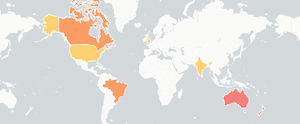Microsoft Azure *Non-Regional Status. Is Microsoft Azure *Non-Regional Down?
Check if Microsoft Azure *Non-Regional is down, official outages, user-reported issues, and outages map.
Is Microsoft Azure *Non-Regional down right now?
Microsoft Azure *Non-Regional is working normally
Multi-service impact in Switzerland North
Be the first to know when Microsoft Azure or other vendors are down
Create one dashboard to track the status of Microsoft Azure and all your vendors. Get outage alerts via Slack, Teams, Datadog, PagerDuty and more.
Create Health DashboardJoin 1,000+ teams monitoring their stack with IsDown.
Microsoft Azure *Non-Regional service health. Issues reported in the last 24 hours
Check the number of user-reported issues over the past 24 hours, grouped into 20-minute intervals. It's normal to see occasional reports, which may be due to individual user issues rather than a broader problem. We only consider an issue widespread if there are multiple reports within a short timeframe.
Microsoft Azure *Non-Regional recent outages and downtime history
IsDown has tracked 20 incidents for Microsoft Azure *Non-Regional since started monitoring Microsoft Azure status in December 2021. We collect data from 4670+ services, and normalize the data to give you a clear picture of the impact of the outage. It will show official Microsoft Azure *Non-Regional outages and also issues that we're started by a spike in crowdsource reports.
| Date | Incident | Duration |
|---|---|---|
|
Dec 22, 2025
12:26 PM UTC
|
Minor
Impact Statement: Starting at 12:26 UTC on 22 December 2025, a subset of customers using Microsof...
|
about 7 hours |
|
Oct 29, 2025
04:00 PM UTC
|
Major
Starting at approximately 16:00 UTC, customers and Microsoft services that leverage Azure Front D...
|
about 9 hours |
|
Oct 09, 2025
07:43 PM UTC
|
Minor
Impact Summary: Starting at 19:43 UTC on 09 October 2025, a subset of customers may experience is...
|
about 5 hours |
|
Sep 27, 2025
12:03 AM UTC
|
Minor
Impact Statement: Starting at 23:54 UTC on 26 September 2025, customers in Switzerland North may ...
|
about 9 hours |
|
Feb 26, 2025
04:48 PM UTC
|
Minor
Active - Azure Active Directory and Azure Chaos Studio unable to create, update, delete, and/or r...
Starting at 16:48 UTC on 26 February 2025, you have been identified as a customer using Managed I...
|
about 5 hours |
|
Apr 25, 2024
12:21 AM UTC
|
Minor
Starting at approximately 00:21 UTC on 25 April 2024, we identified an issue with multiple Azure ...
|
about 6 hours |
|
Feb 07, 2024
09:20 AM UTC
|
Minor
Impact Statement: Starting as early as 09:20 UTC on 07 Feb 2024, customers accessing their resour...
|
about 3 hours |
|
Jan 21, 2024
01:57 AM UTC
|
Major
Azure Resource Manager - ARM call failures causing service management impact - Validating Mitigation
Impact Statement: Starting at 01:57 UTC on 21 January 2024, customers may experience issues using...
|
about 8 hours |
|
Jan 19, 2024
06:55 AM UTC
|
Minor
Impact Statement: Starting at 06:55 UTC on 19 Jan 2024, customers attempting to use Cloud Shell w...
|
about 15 hours |
Be the first to know when Microsoft Azure *Non-Regional goes down
One place to monitor all your cloud vendors. Get instant alerts when an outage is detected.
User comments about Microsoft Azure *Non-Regional status
See what users are saying about Microsoft Azure *Non-Regional issues that impacted them and how they are affected by the outage. You can see if other users are experiencing the same issues and if there are any workarounds or solutions.
-
azure static sites not available from Spain.
Microsoft Azure *Non-Regional components or services current status
| Component | Status |
|---|---|
| Action Groups | OK |
| Activity Log | OK |
| Alerts | OK |
| Alerts (Classic) | OK |
| Azure Active Directory (Azure AD) | OK |
| Azure Active Directory B2C | OK |
| Azure Advisor | OK |
| Azure Arc | OK |
| Azure Artifacts † | OK |
| Azure Blueprints | OK |
| Azure Boards † | OK |
| Azure Bot Service | OK |
| Azure Communication Services | OK |
| Azure Container Service on Azure Stack HCI | OK |
| Azure DevOps † | OK |
| Azure DNS | OK |
| Azure Front Door | OK |
| Azure Front Door (classic) | OK |
Be the first to know when Microsoft Azure or other vendors are down
Create one dashboard to track the status of Microsoft Azure and all your vendors. Get outage alerts via Slack, Teams, Datadog, PagerDuty and more.
Create Health DashboardJoin 1,000+ teams monitoring their stack with IsDown.
Monitoring Microsoft Azure since December 2021
*Non-Regional is part of Microsoft Azure. Check the Microsoft Azure's status.
Reach out in social media at X account.
Support at website.
Check their status page.
6 incidents in 2025


